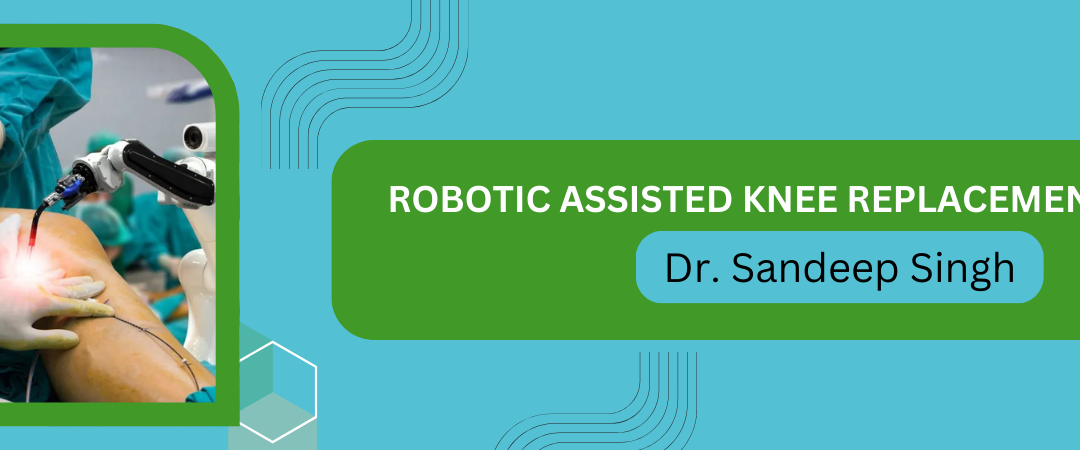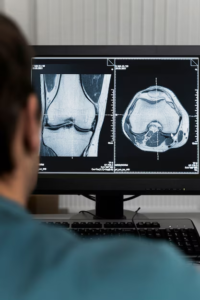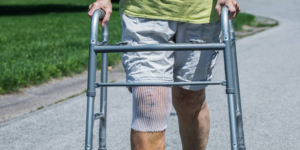Healthy knees are the foundation of mobility and independence. Unfortunately, millions of people around the world struggle with knee-related issues. According to the World Health Organization, over 22% of adults globally suffer from knee osteoarthritis, with many requiring surgical intervention.
Dr. Sandeep Singh, a distinguished Orthopedic Doctor in Bhubaneswar, emphasizes:
“Knee conditions can drastically affect one’s quality of life, limiting mobility, independence, and overall well-being. Thankfully, modern medical advancements, particularly robotic technology, are transforming how we approach knee replacement surgeries.”
Dr. Singh is a trusted orthopedist for people seeking Robotic Assisted Knee Replacement Surgery in Bhubaneswar.
This blog will explore the benefits, success rates, and recovery process of robotic knee replacement, offering a complete guide for those considering this life-changing procedure.
Is robotic surgery better for knee replacement?

Advantages
- Less Invasive: Robotic systems allow for smaller incisions, reducing trauma to surrounding tissues. This leads to a lower risk of complications and faster recovery.
- More Natural Feel: Precision implant placement ensures better alignment, resulting in a more natural knee movement and feel post-surgery.
- Less Pain: Minimally invasive techniques and accurate adjustments minimize post-operative pain, allowing patients to resume daily activities sooner.
- Enhanced Precision: The robotic system uses advanced imaging to create a detailed knee map, enabling surgeons to make precise cuts and alignments.
- Personalized Fit: Robotic technology ensures implants are customized to fit the patient’s unique anatomy, reducing discomfort and enhancing mobility.
- Minimized Errors: The system reduces the likelihood of human error by providing real-time feedback during surgery.
- Faster Recovery: Reduced soft tissue damage and accurate implant placement lead to quicker rehabilitation.
- Improved Longevity: Better alignment and positioning contribute to the durability of knee implants.
However, robotic surgery also has its challenges:
- Mechanical Failure: Although rare, technical issues or mechanical malfunctions with the robotic system could delay the procedure.
- Cost: It is often more expensive than traditional methods.
- Availability: Limited access in some regions may delay treatment.
- Learning Curve: Surgeons require specialized training, which may not be universally available.
Are you or a loved one considering robotic knee surgery? Consult an experienced orthopedic specialist to discuss your personalized treatment options.
You’ve seen why robotics can revolutionize knee replacement, but what about its success rate? Let’s take a closer look at how effective this technology truly is.
What is the success rate of robotic knee replacement?
Robotic knee replacement boasts remarkable success rates globally. Studies indicate that over 90% of patients experience significant pain relief and improved mobility after surgery. In India, the adoption of robotic-assisted procedures has steadily increased, with a success rate aligning with global benchmarks.
The high success rate is attributed to factors such as:
- Enhanced surgical precision.
- Reduced complications and infections.
- Personalized implant placement for better function and longevity.
Dr. Sandeep Singh, renowned for Knee Replacement Surgery in Bhubaneswar, adds:
“Robotic systems ensure better outcomes by eliminating inaccuracies. Patients can regain confidence in their movement with reduced post-operative discomfort. This is a testament to how technology enhances patient care.”
Understanding the success rate is encouraging, but what’s the experience like during and after surgery? Here’s what you can expect.
Robotic Surgery, Duration and Recovery
 Robotic-assisted knee replacement follows a structured process:
Robotic-assisted knee replacement follows a structured process:
Pre-Surgical Imaging: High-resolution scans, such as CT or MRI, are taken to create a 3D model of the patient’s knee. This model guides the surgeon in planning the procedure.
Surgical Procedure:
- Mapping and Calibration: During surgery, the surgeon calibrates the robotic system to match the patient’s anatomy and the surgical plan. They place sensors and markers on the knee for real-time tracking.
- Precise Execution: Theorthopedic surgeon controls the robotic arm, which guides tools with unparalleled precision to remove damaged tissue and prepare the bone for the implant.
- Implant Placement: The implant is positioned precisely, ensuring optimal alignment and fit. Real-time data from the robotic system confirms accuracy throughout the procedure.
- Final Adjustments: The surgeon ensures proper alignment and stability of the knee before closing the incision.
The procedure typically takes 1-2 hours, depending on the complexity and individual factors.
Post-Surgical Monitoring: Patients are closely observed for a few hours to ensure a smooth transition from the operating room.
 Recovery Timeline:
Recovery Timeline:
First Few Days: Pain and swelling are managed with medications and ice packs. Physiotherapy often begins within 24 hours to restore basic knee movement. Patients are encouraged to stay hydrated and consume a nutritious diet to support healing. The doctor may recommend knee sleeves or stockings to reduce swelling and prevent blood clots.
2 Weeks: Gradual improvement in mobility is seen, often with the help of a walker or cane. Physiotherapy sessions focus on strengthening muscles and improving range of motion. Adequate hydration and balanced meals rich in protein and vitamins are crucial during this phase.
1 Month: Most patients can walk short distances independently and perform light activities. If swelling persists, patients may continue using compression garments. Rehabilitation exercises become more intensive, helping to improve strength and flexibility. Proper hydration and nutritional intake remain essential for recovery.
3-6 Months: Full recovery with a return to regular activities, including low-impact exercises like walking and swimming. By this stage, most patients experience significant improvement in mobility and a reduction in pain. Continued physiotherapy and adherence to a healthy lifestyle can further enhance outcomes.
Curious about how long recovery might take for your specific case? Discuss your options with a trusted orthopedic surgeon today.
Conclusion
For those dealing with debilitating knee pain, robotic-assisted knee replacement surgery offers hope and a path to renewed mobility. This advanced approach ensures precision, personalized care, and faster recovery, allowing patients to regain their independence and enjoy life once again.
Accomplished Orthopedist Dr. Sandeep Singh believes:
“Medical advancements continue to transform lives. By embracing innovation, we can offer patients solutions that were once thought impossible. Support and expert guidance are just as crucial as technology in the journey to recovery.”
Still have questions about robotic knee replacement? Let’s address the most common concerns to help you make an informed decision.
FAQs
What are the risks associated with robotic knee replacement?
Robotic knee replacement is generally safe, but like any surgery, it carries risks such as infection, blood clots, or rare mechanical issues with the robotic system.
Can older adults undergo robotic knee replacement?
Yes, age is not a limiting factor. Eligibility depends more on overall health and the severity of the knee condition.
Is robotic knee surgery painful?
The surgery itself is painless due to anesthesia. Post-operative pain is managed with medications and typically reduces significantly within a few weeks.
How do I prepare for robotic knee surgery?
Pre-surgical preparations include routine medical tests, maintaining a healthy diet, and following your doctor’s instructions about medications.
Are there alternatives to robotic-assisted knee replacement?
Yes, traditional knee replacement, partial knee replacement, and non-surgical treatments are alternatives. However, robotic surgery offers unmatched precision and recovery benefits.
Do you still have concerns about knee replacement options? Reach out to a specialist today to explore the best path for your recovery.
Reference Links:
https://orthoinfo.aaos.org/en/treatment/robotic-assisted-joint-replacement/
Disclaimer: The information shared in this content is for educational purposes only and not for promotional use.


 Robotic-assisted knee replacement follows a structured process:
Robotic-assisted knee replacement follows a structured process: Recovery Timeline:
Recovery Timeline: